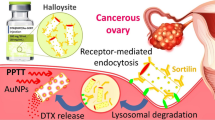Abstract
Combining diagnostic and therapeutic functions in one agent is a promising strategy in the development of personalized approaches to the treatment of cancer. The opportunity to combine diagnostics and therapy appeared with the development of nanobiotechnologies and was realized in the concept of theranostics. To date, a number of promising agents based on nanomaterials capable of diagnosing, targeted therapeutic effects, and monitoring the response of tumor cells were obtained within the approach of theranostics. In this work, a new type of theranostic complexes based on upconversion nanoparticles coated with polyethylene glycol and functionalized with the DARPin–LoPE recombinant targeted toxin was developed. Selective binding of complexes to human breast adenocarcinoma cells overexpressing the HER2 receptor and specific toxicity to them were shown.

Similar content being viewed by others
REFERENCES
Deyev, S.M. and Lebedenko, E.N., Mol. Biol., 2017, vol. 51, no. 6, pp. 788–803. https://doi.org/10.1134/S002689331706005X
Kim, H., Kwak, G., Kim, K., et al., Biomaterials, 2019, vol. 213, p. 119207. https://doi.org/10.1016/j.biomaterials.2019.05.018
Singh, R., 3 Biotech., 2019, vol. 9, no. 11, p. 415. https://doi.org/10.1007/s13205-019-1940-0
Heer, S., Kompe, K., Gudel, H.U., et al., Adv. Mater., 2004, vol. 16, pp. 2102–2105. https://doi.org/10.1002/adma.200400772
Chen, J. and Zhao, J.X., Sensors, 2012, vol. 12, pp. 2414–2435. https://doi.org/10.3390/s120302414
Nguyen, P.D., Son, S.J., and Min, J., J. Nanosci. Nanotechnol., 2014, vol. 14, no. 1, pp. 157–174. https://doi.org/10.1166/jnn.2014.8894
Guryev, E.L., Volodina, N.O., Shilyagina, N.Y., et al., Proc. Natl. Acad. Sci. U. S. A., 2018, vol. 115, no. 39, pp. 9690–9695. https://doi.org/10.1073/pnas.1809258115
Frankel, A.E., Woo, J.H., and Neville, D.M., Immunotoxins, in Principles of Cancer Biotherapy, Old-ham, R.K. and Dillman, R.O., Eds., Dordrecht: Springer; 2009, pp. 407–449. https://doi.org/10.1007/978-90-481-229-9
Shapira, A. and Benhar, I., Toxins, 2010, vol. 11, pp. 2519–2583. https://doi.org/10.3390/toxins2112519
Proshkina, G.M., Kiseleva, D.V., Shilova, O.N., et al., Mol. Biol., 2017, vol. 51, no. 6, pp. 997–1007. https://doi.org/10.1134/S0026893317060140
Ménard, S., Casalini, P., Campiglio, M., et al., Cell. Mol. Life Sci., 2004, vol. 61, no. 23, pp. 2965–2978. https://doi.org/10.1007/s00018-004-4277-7
Andreani, T., de Souza, A.L., Kiill, C.P., et al., Int. J. Pharm., 2014, vol. 473, nos. 1–2, pp. 627–635. https://doi.org/10.1016/j.ijpharm.2014.07.049
Sokolova, E.A., Shilova, O.N., Kiseleva, D.V., et al., Int. J. Mol. Sci., 2019, vol. 20, no. 10, p. 2399. https://doi.org/10.3390/ijms20102399
Bioconjugate Techniques, 2nd ed., Hermanson, G., Ed., Rockford: Academic, 2008.
Maeda, H., J. Control. Release, 2012, vol. 164, no. 2, pp. 138–144. https://doi.org/10.1016/j.jconrel.2012.04.038
Funding
This study was supported by the Federal Special-Purpose Program of the Ministry of Education and Science of the Russian Federation “Research and Development on Priority Directions of the Scientific and Technologi-cal Complex of Russia for 2014–2020” (Agreement no. RFMEFI58418X0033).
Author information
Authors and Affiliations
Corresponding author
Ethics declarations
The authors declare that they have no conflict of interest. This article does not contain any studies involving animals or human participants performed by any of the authors.
Additional information
Translated by M. Batrukova
Rights and permissions
About this article
Cite this article
Guryev, E.L., Smyshlyaeva, A.S., Shilyagina, N.Y. et al. Multifunctional Complexes Based on Photoluminescent Upconversion Nanoparticles for Theranostics of the HER2-Positive Tumors. Dokl Biochem Biophys 491, 73–76 (2020). https://doi.org/10.1134/S160767292002009X
Received:
Revised:
Accepted:
Published:
Issue Date:
DOI: https://doi.org/10.1134/S160767292002009X



